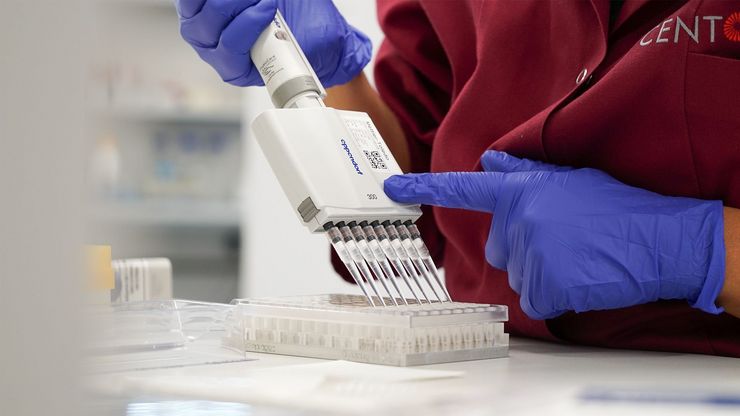Key Diseases
Duchenne Muscular Dystrophy
CENTOGENE supports the development of new therapies for Duchenne Muscular Dystrophy by offering actionable real-world insights along the end-to-end pharmaceutical development workflow.
What Is Duchenne Muscular Dystrophy?
Duchenne Muscular Dystrophy (DMD) is a severe, progressive, muscle-wasting disorder, occurring in every 5-6,000 male births. DMD is mild and often even clinically unnoticed in females. DMD’s earliest symptoms arise at around 2-3 years, with difficulties climbing stairs, a waddling gait, and frequent falls. Most patients cannot walk by age 10-12 and will need assisted ventilation at around 20 years. Cognitive impairment is relatively frequent (30%) and due to brain expression of specific dystrophin isoforms. Patients have a median life expectancy of 40.9 years and cardiomyopathy is the leading cause of death (a rather late manifestation due to the specific (protective) interaction network of dystrophin in the heart).
CENTOGENE Support for DMD
- CENTOGENE’s Biodatabank holds one of the largest worldwide genetic dataset in DMD
- Characterize DMD patients with retrospective patient data from our Biodatabank
- Identify DMD biomarkers via our metabolomics
- Outreach to DMD patients via our network of >30,000 physicians
- Establish cellular disease models and, for example, test compounds with our 13 DMD-patient-derived fibroblast cell lines
At CENTOGENE, we see it as our task to support the Pharma industry’s development of treatments for all rare and neurodegenerative diseases by generating actionable real-world insights and services leveraged from CENTOGENE’s vast repository of real-world data, our expertise in genomics, medicine and bioinformatics, and our multiomic diagnostics capabilities.
Duchenne Muscular Dystrophy in Detail
DMD is the result of loss-of-function dystrophin mutations. Dystrophin connects the actin cytoskeleton, the network of interlinking protein filaments within a cell, to the extracellular matrix, the complex network of proteins and carbohydrates outside the cell, forming a huge macromolecular complex. This “bridging” function is essential for muscle structural integrity during contraction. In DMD, muscle damage initiates an inflammatory response with replacement of muscle by fibrotic tissue. The N- and C-termini of dystrophin are essential whereas the intermediate part is formed by repeats of modular blocks with some functional redundancy.
This explains the milder phenotype of deletions in the intermediate region (Becker muscular dystrophy, BMD) and the therapeutic approach via exon skipping and micro- and mini-dystrophin gene therapy. Females, often referred to as manifesting carriers, have an increased chance of changes in heart function and may experience mild muscle weakness, fatigue, and pain or cramping in their muscles.

Dystrophin Is One of the Largest Genes in the Human Genome (79 Exons):
DMD causing mutations:
- 60-70% large deletions
- 5-15% large duplications
- 20%-point mutations, small deletions, and insertions
- Loss-of-function mutations lead to DMD
- In-frame, less severe mutations lead to BMD (milder phenotype)
- 30% probability of de novo mutations (tend to cluster in hotspots)
DMD is characterized by high phenotypic variability, with 6 identified genetic modifiers which influence disease progression, all located in the X-chromosome:
- SPP1 - secreted phosphoprotein 1 or osteopontin (extracellular matrix)
- LTBP4 - latent TGF-beta binding proteins (extracellular matrix)
- CD40 - cluster of differentiation 40 (inflammatory response)
- THBS1 - thrombospondin 1 (extracellular matrix)
- ACTN3 - F-actin cross-linking protein (actin binding protein)
- TCTEX1D - dynein light chain Tctex (cytoskeleton motor protein)
DMD Diagnosis and Screening
- Diagnosis is based on delayed motor milestones (mean age at diagnosis 4.4 years) – pre-symptomatic treatment could yield improved outcomes.
- Diagnostic biomarker: Plasma creatine kinase (CK) – rather unspecific and prone to false positives in newborns. A new kit for muscle specific CK detection in DBS of newborns has recently received FDA approval.
- Genetic testing is required to confirm diagnosis, permit carrier analysis of the mother, and determine whether the patient is a candidate for mutation-specific therapies.
- As it is a genetic, X-linked disease, DNA-sequencing is essential to identify carriers and characterize patients. There are some exon-skipping drugs available suitable for a subset of patients with certain mutations.
There are multiple treatments approved and in development for either symptomatic relief or overcoming the genetic defect. An overview: https://www.frontiersin.org/articles/10.3389/fphar.2022.950651/full
Currently there are about 70 clinical trials ongoing for patients with DMD. So, there are opportunities for patients to participate in research. As a rapid progressing disease, patients have to be included early in their lives.
DMD Unmet Needs
- Medical: the best outcome of currently approved therapies (4 exon-skipping drugs) is a milder phenotype
- Diagnostic: improvement of diagnostic marker
DMD Therapeutic Challenges
- Delivery to target tissue
- Short therapeutic window (early onset, rapid progression)
- Dystrophin is the largest human gene. Length of oligonucleotide carried by viral vectors and lipid particles is limited
- All muscles are affected by DMD (30-40% body mass)
- Muscle fibers are not easily accessible
- Lack of validated biomarkers to monitor therapeutic effects (essential for the success of clinical studies)
- DMD therapy is a crowded arena (40 companies and 24 recruiting interventional studies*)
*Timonen et al., Int. J.Neon. Screening, 2019
CENTOGENE and Duchenne Muscular Dystrophy
End-to-End Offers Along the Pharma Workflow
Established CENTOGENE Strengths in DMD
- One of the largest genetic dataset in DMD, with >3,000 DMD diagnosed patients worldwide, including more than 1,000 patients experiencing a DMD exon deletion and circa 650 with a single nucleotide variant mutation
- A relevant fraction of DMD patients represent quite unique ethnicities that are generally not covered in current clinical programs
- Patient multiomic characterization
- Patient biomarker identification via metabolomics
- Established global physician network
- 13 patient-derived fibroblast cell lines
Discovery & Early Clinical Research
- New target identification based on patient-derived cell lines
- Better understanding and characterization of diseases against variants and mutations based on multiomic testing
- Combined with our metabolomic capabilities we can not only characterize the patients deeply, but we can also co-develop markers for disease progression and treatment effect
- Access fresh patient samples via engagement of in-house physician network
Drug Development
- Clinical studies: access to patients via physician engagement in all geographic areas. This would enable faster recruitment and shorten the time to market.
- Clinical studies: monitoring treatment efficacy and disease progression via biomarkers
Patient Associations for DMD
If you are a DMD patient in search of better understanding of the disease or your potential next steps, we would direct you to the following patient organizations:
- Parent Project Muscular Dystrophy (PPMD) – Duchenne patient advocacy group focused on research and treatments
- CureDuchenne – patient advocacy group with an innovative venture philanthropy model that funds research, early diagnosis, and treatment access
- World Duchenne Organization – global umbrella or national patient organizations
CENTOGENE is also in close contact with TREAT NMD, a global network of experts in the neuromuscular field. Their mission is to accelerate the development of effective treatments; and establish the best in diagnosis and care for people worldwide

Contact Us To Find Out More!

Partners
CENTOGENE is working together with partners to identify lead compounds and drug targets quickly and de-risk orphan drug development.

Single Gene Analysis (MLPA)
Many genetic diseases are known to be caused by changes or variants in a single gene. At CENTOGENE, we provide the most comprehensive range of diagnostic tests for a broad spectrum of single-gene disorders.

Genetic Counseling
CENTOGENE only provides genetic testing ordered by a doctor. Results from genetic testing can have a profound impact on your life. We strongly recommend that you seek genetic counseling. Counselors can advise you and your family on whether to take a genetic test. They can also help you understand your genetic test results and their implications. The following question and answer form can support discussions with your doctor about genetic testing

